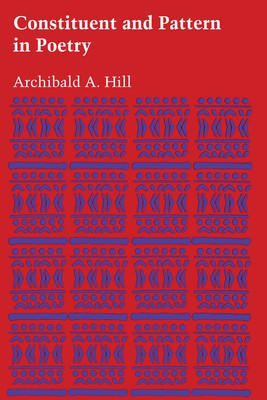
- We will send in 10–14 business days.
- Author: Archibald A Hill
- Publisher: University of Texas Press
- ISBN-10: 0292741146
- ISBN-13: 9780292741140
- Format: 15.2 x 22.9 x 1 cm, softcover
- Language: English
- SAVE -10% with code: EXTRA
Reviews
Description
Constituent and Pattern in Poetry is a collection of essays on literature and language. It is built on the assumption that works of literature have existence in the real world and that they may be analyzed in a fashion that is not totally subjective. Using models derived from structural linguistics, Archibald A. Hill presents a number of theoretical contributions to the study of poetry, as well as new ways of looking at specific poems. The book as a whole provides an overview of the tools and ideas Hill has developed for analyzing works of literature, and it is the first time the essays have been gathered together in one volume. The book is divided into three sections: Definition of Literature and Study of Its Patterns, Types of Meaning and Imagery, and Principles for Interpreting Meaning. Each section opens with a theoretical essay, followed by three essays that work analytically with specific poets and poems using the methods defined in the first. In his examination of such poets as Hopkins, Browning, Milton, Blake, Keats, and Dickinson, Hill uses such proposals as the law of least lexical contribution and maximal contextual contribution; the hypothesis that, when possible meanings occur together in a cluster, they support each other; and the idea that it is sometimes possible to recover underlying language sequences from which the author has departed for identifiable reasons. By applying these suppositions to the study of particular poems, Hill shows how the reader may arrive at statements about the relative artistic merit of works of literature.
EXTRA 10 % discount with code: EXTRA
The promotion ends in 7d.16:18:04
The discount code is valid when purchasing from 10 €. Discounts do not stack.
- Author: Archibald A Hill
- Publisher: University of Texas Press
- ISBN-10: 0292741146
- ISBN-13: 9780292741140
- Format: 15.2 x 22.9 x 1 cm, softcover
- Language: English English
Constituent and Pattern in Poetry is a collection of essays on literature and language. It is built on the assumption that works of literature have existence in the real world and that they may be analyzed in a fashion that is not totally subjective. Using models derived from structural linguistics, Archibald A. Hill presents a number of theoretical contributions to the study of poetry, as well as new ways of looking at specific poems. The book as a whole provides an overview of the tools and ideas Hill has developed for analyzing works of literature, and it is the first time the essays have been gathered together in one volume. The book is divided into three sections: Definition of Literature and Study of Its Patterns, Types of Meaning and Imagery, and Principles for Interpreting Meaning. Each section opens with a theoretical essay, followed by three essays that work analytically with specific poets and poems using the methods defined in the first. In his examination of such poets as Hopkins, Browning, Milton, Blake, Keats, and Dickinson, Hill uses such proposals as the law of least lexical contribution and maximal contextual contribution; the hypothesis that, when possible meanings occur together in a cluster, they support each other; and the idea that it is sometimes possible to recover underlying language sequences from which the author has departed for identifiable reasons. By applying these suppositions to the study of particular poems, Hill shows how the reader may arrive at statements about the relative artistic merit of works of literature.


Reviews